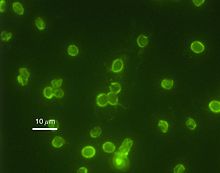Cryptosporidium parvum
| Cryptosporidium parvum | |
|---|---|
 |
|
| Immunofluorescence image of C. parvum oocysts | |
| Scientific classification | |
| (unranked): | SAR |
| Phylum: | Apicomplexa |
| Class: | Conoidasida |
| Order: | Eucoccidiorida |
| Family: | Cryptosporidiidae |
| Genus: | Cryptosporidium |
| Species: | C. parvum |
| Binomial name | |
|
Cryptosporidium parvum |
|
Cryptosporidium parvum is one of several species that cause cryptosporidiosis, a parasitic disease of the mammalian intestinal tract.
Primary symptoms of C. parvum infection are acute, watery, and nonbloody diarrhea. C. parvum infection is of particular concern in immunocompromised patients, where diarrhea can reach 10–15 l per day. Other symptoms may include anorexia, nausea/vomiting, and abdominal pain. Extra-intestinal sites include the lung, liver, and gall bladder, where it causes respiratory cryptosporidosis, hepatitis, and cholecystitis, respectively.
Infection is caused by ingestion of sporulated oocysts transmitted by the faecal-oral route. In healthy human hosts, the median infective dose is 132 oocysts. The general C. parvum lifecycle is shared by other members of the genus. Invasion of the tip of ileal enterocytes by sporozoites and merozoites causes pathology seen in the disease.
Infection is generally self-limiting in immunocompetent people. In immunocompromised patients, such as those with AIDS or those undergoing immunosuppressive therapy, infection may not be self-limiting, leading to dehydration and, in severe cases, death.
C. parvum oocysts are very difficult to detect and therefore diagnose. The oocysts in fecal samples would indicate if the parasite is present in the body, but they are very small in size, so detection is made very difficult. Doing a fecal ELISA method to detect the presence of the parasite would eliminate the difficulty due to the small size and many other methods are unable to distinguish between past and present infections; something serological ELISA would not allow to distinguish.
...
Wikipedia
